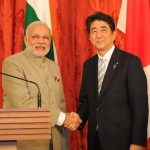IDR Blog
Resetting India–Nepal ties: Oli shows his pragmatism
The visit by Nepalese Prime Minister KPS Oli to Delhi on April 6 continued a tradition going back to 1990, wherein the elected leader of Kathmandu makes India the first destination for an official visit. While this is a reiteration of the resilience of bilateral ties, the three-day Oli visit also marked the beginning of a new reset punctuation in the distinctive yet discordant Delhi-Kathmandu relationship.
What is distinctive about this bilateral? The two nations have an open and free border and Nepalese citizens have unfettered access to every aspect of the Indian eco-system by way of education and employment that no other neighbour of India enjoys. The most distinctive and unprecedented feature is the provision that Nepalese citizens serve in the Indian military – mostly in the Indian army and its legendary Gorkha regiments – and can rise up to three star rank.
The India-Nepal relationship has a socio-cultural and military depth that goes back centuries. This has continued in recent decades when Nepal made the transition from a traditional monarchy to a constitutional one in 1990. However, the political trajectory of the last 27 years has been turbulent; one indicator is there have been 27 prime ministers in as many years!
New Delhi played a major role in Nepal’s transition from an absolute monarchy to a constitutional one and, post 2006, to a democratic republic. However the last few years have been marked by political discord and a sharp Kathmandu-Delhi divergence over the electoral status of the ‘madhesis’ (plains people) who have close links with their Indian cousins across the border in the neighbouring Indian states of Bihar and Uttar Pradesh.
The low point was in late 2015 when an informal blockade, tacitly endorsed by Delhi, caused the citizens of Nepal acute discomfort, for the land-locked Himalayan nation is almost totally dependent on India for imports of essentials like food and fuel. Oli was Prime Minister of Nepal at the time and skilfully used this sentiment to his electoral advantage on an anti-India political campaign. The gains were substantial and Oli was back in the saddle for a second term in February 2018 with a substantive parliamentary majority.
The orientation of the new Oli led government was evident in recent weeks when the first foreign leader welcomed in Kathmandu, on March 5, was Pakistani Prime Minister Shahid Khaqan Abbasi. Unprecedented by the benchmarks of the India-Nepal special relationship but not surprising for the more observant students of South Asian regional developments.
After ties with India soured in 2015, Oli established contact with China, in 2016, marking the beginning of a closer Kathmandu-Beijing relationship, with generous financial support from the larger neighbour. Nepal was playing the China card deftly – as other South Asian neighbours of India, barring Bhutan, have done over the last decade.
However, in keeping with the geographical, economic/trade and political compulsions that characterise Nepal’s ties with both its giant neighbours, it was prudent and pragmatic for Oli to hit the reset button with India even while deepening the engagement with China.
This is what was achieved during the April 6 visit and appropriately reflected in the joint statement which noted: “The two Prime Ministers resolved to work together to take bilateral relations to newer heights on the basis of equality, mutual trust, respect and benefit.” Mutual trust between India and Nepal that had been eroded appears to have been restored.
Indicating the reset in ties, the statement emphasised that “Prime Minister Modi assured Prime Minister Oli that India remains committed to strengthening its partnership with Nepal as per the priorities of the Government of Nepal.”
Hopefully, this will be seen in Kathmandu as a case of Oli hitting the reset button satisfactorily, such that Nepal does not have to make a binary choice in its bilaterals with two giant neighbours.
Courtesy: http://southasiamonitor.org/news/resetting-india-nepal-ties-oli-shows-his-pragmatism/sl/27024




